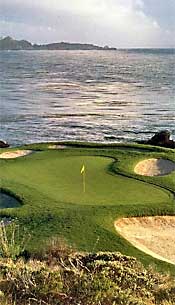Golf course "Archie Texture"
Norm, my biological father, (although he often denied it, due to my tendency to go from 5-under to 5-over in three holes and withdraw from junior tournaments at the turn) dragged me all over Europe and the US serving as his personal golf mule. I didnt know I was a caddie for years, because Dad was thrifty. According to Dad, mules worked for food and caddies got paid.
 I also served as a migrant golf worker, under the same financial arrangement, a sort of barter agreement, wherein I was allowed to live if I mowed greens, changed cups and ran the pro shop until dark. While this may seem like an unfair business deal, I actually managed to profit from the situation.
I also served as a migrant golf worker, under the same financial arrangement, a sort of barter agreement, wherein I was allowed to live if I mowed greens, changed cups and ran the pro shop until dark. While this may seem like an unfair business deal, I actually managed to profit from the situation.
I got quite an education in golf course architecture at an early age and quickly learned how to tell if a particular hole was a good one, if a bunker was the right kind or in the right place, and if the maintenance standards were acceptable or deplorable. All I had to do was simply listen to Dad and his pro golfer buddies.
Here's how it worked: If they said nothing, nothing at all, the course was well designed, properly maintained and had just the right number and placement of bunkers. If, however, the player poured forth a constant stream of obscenities all during the round, combined with vitriolic oaths condemning an architect or superintendent to burn in hell, in conjunction with constant muttering and teeth grinding until the player spit out white powdered dust then I knew we were on a bad course.
If, however, the player poured forth a constant stream of obscenities all during the round, combined with vitriolic oaths condemning an architect or superintendent to burn in hell
This was not an absolute rule, because sometimes, on the very same course that had been damned to eternal hellfire the previous week, a miracle would take place and the course design and maintenance would attain great heights of glory and brilliance. I suspected this was the result of better scoring and said as much, in the company of Dad and his playing partners, a young fellow named Jerry Heard that would soon lead the money list on tour. Rod Curl, also a tour pro, was in Dads training group.
Because I spoke such blasphemy within earshot of Dad's playing partners, I was immediately fired from my position of caddie, without a fair hearing or trial, and banished to range pickup duty, without benefit of a picker, just two shag bags. (Had I known that breaking the taboo of questioning pro golfers as to their inconsistent and randomly fluctuating course assessments would result in my freedom, I would have offered inflammatory opinions years earlier.)

Not long after this unspeakable act, Dad took me to Pebble Beach, not as a caddie, as I was no longer trustworthy, but to actually play the course. Standing on a cliff, looking across a ravine at a green, I had one of those moments of pure awareness; I resolved to discover the difference between good golf design and the kind that triggered Tourette's Syndrome in scratch players.
I announced this to the family and got no response, probably because I had made similar proclamations regarding learning all there was to know about dinosaurs, UFOs, Confederate cavalry generals and Knute Rockne's offensive strategy. I would soon find out there was a lot more in the library about Rockne than golf course architecture.
There were occasional old news stories on microfiche — and those seemed to be mostly about Tillinghast — but few books. I did find one by Robert Hunter called "The Links", but it was a little dry for a 15 year old range rat, so I gave up and moved on to studying Jimi Hendrix.
In the mid '70s, while I was helping build a truly awful municipal layout, the fascination with golf design returned and I was able to acquire a few old books on the subject by hitting the rare book stores. I thought a thorough knowledge of golf architecture would help me in the future and it did; mostly by providing quotes to use during critical green committee "discussions" concerning tree removal and making the course more difficult to attract more players. I know, that last one surpasses the definition of oxymoron, but it was always there.
The point of this essay is to encourage the GCS to learn as much about course architecture as one would spend on soil science, especially classic architecture. Its not about whether you will ever work in golf architecture as much as it is important to know such a fundamental aspect of the game if you are the person in charge of the course.
Fortunately, there are lots of books available on the subject now and if you need a list, watch the video where Cousin Ludell names a few works. Read that list and you will have a good foundation.
Just dont buy anything Ludell writes.



0 Comments
Recommended Comments
There are no comments to display.